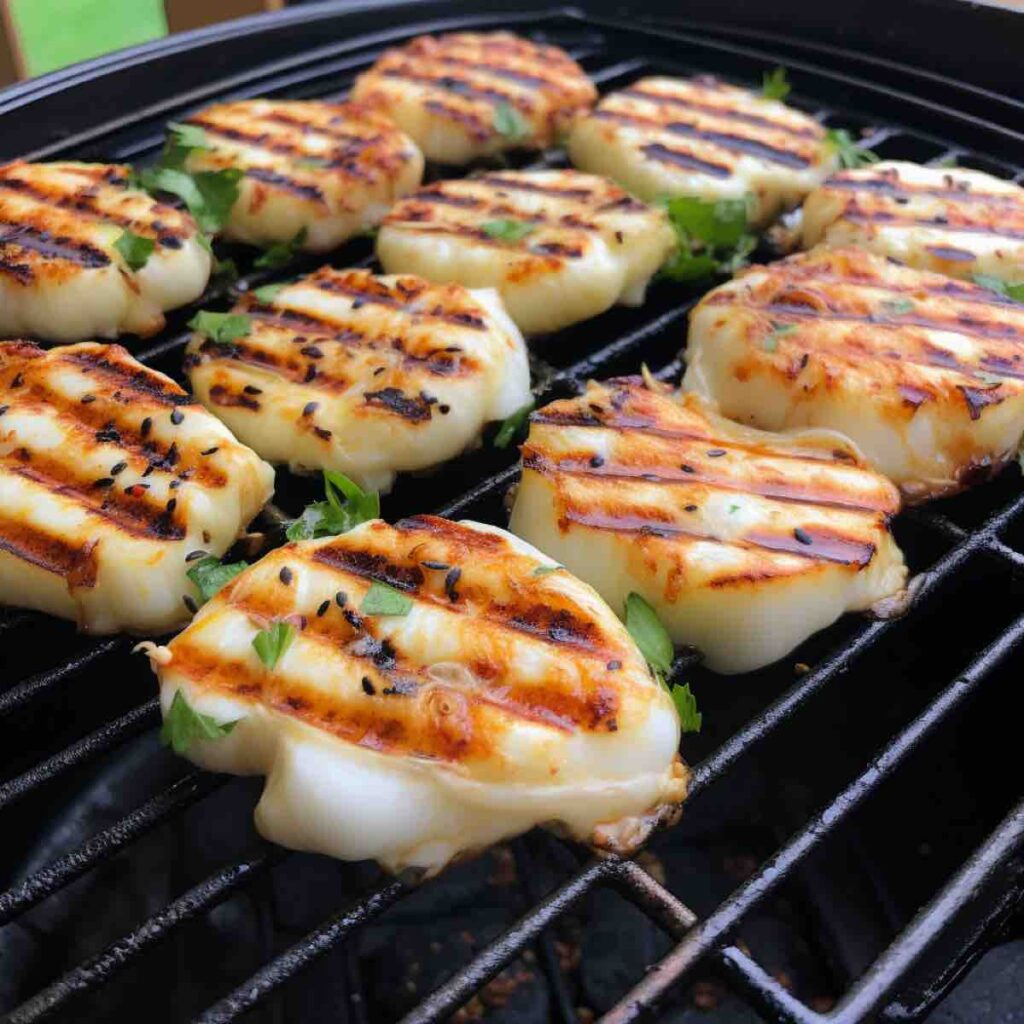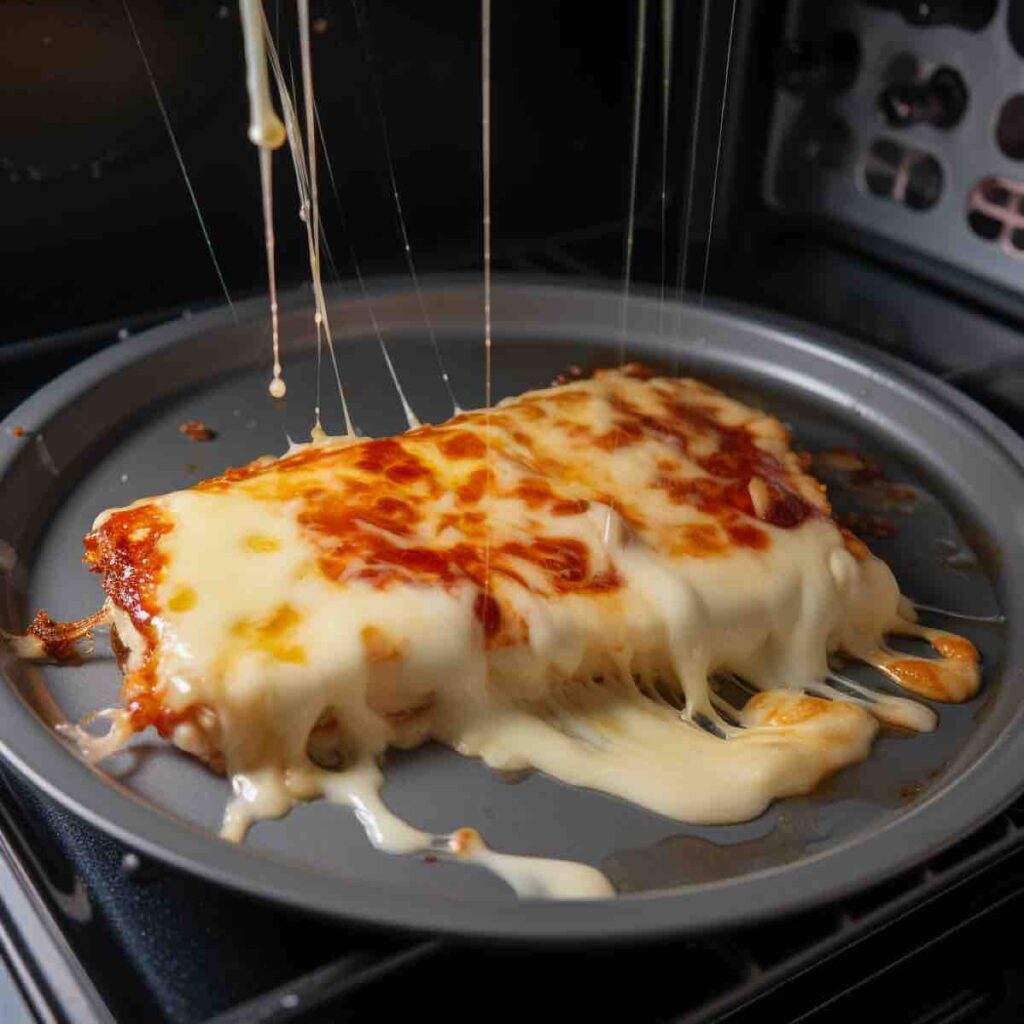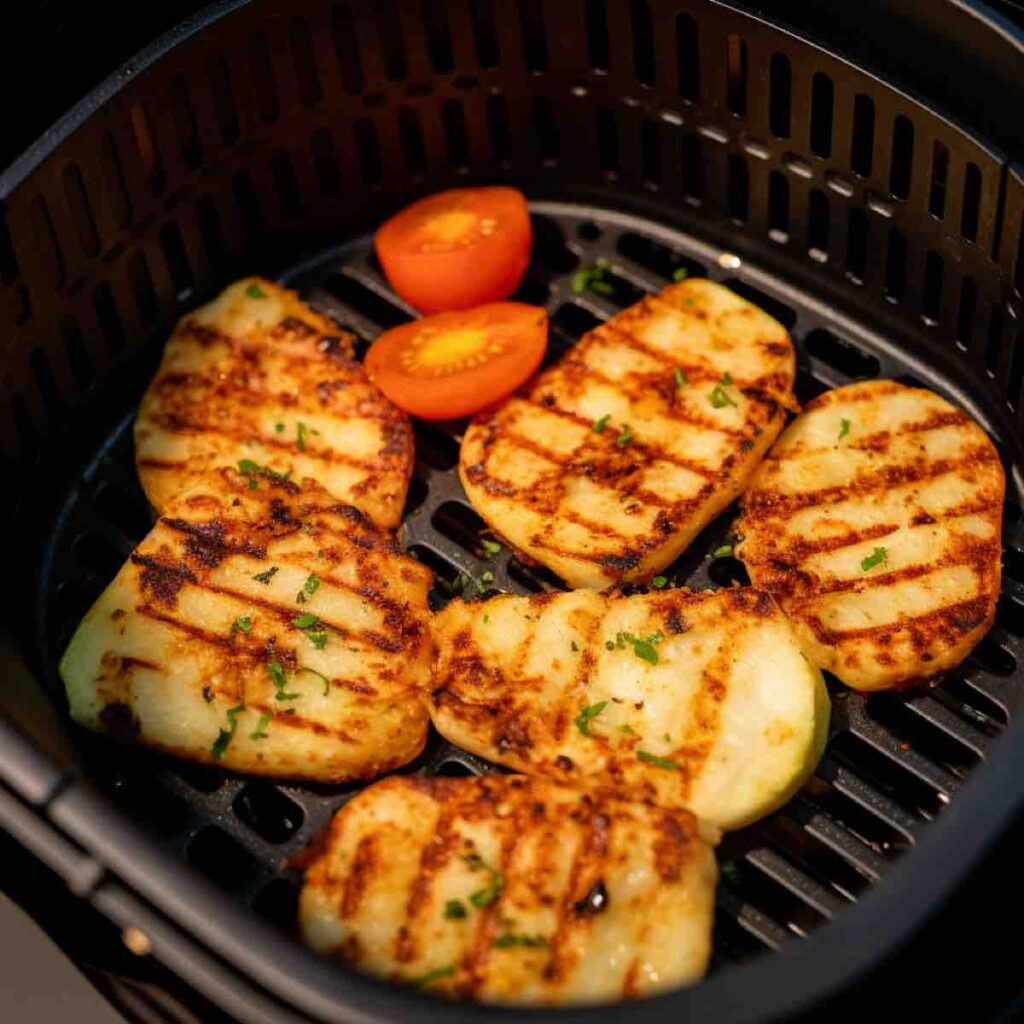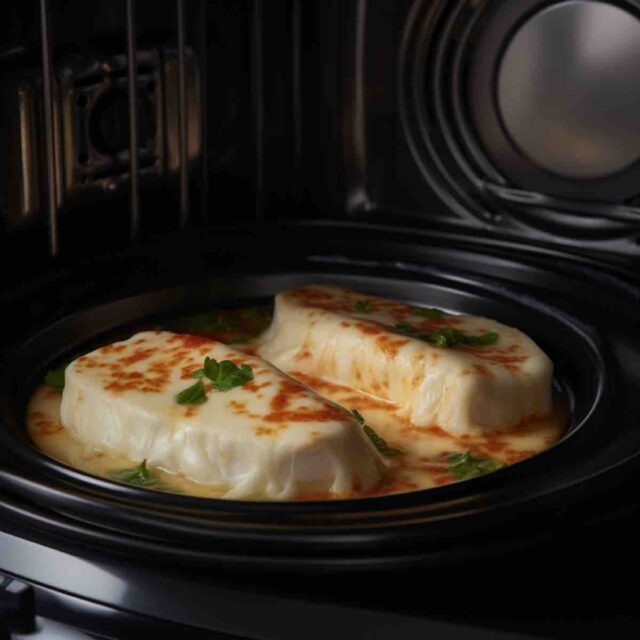Halloumi is a popular cheese originating from Cyprus and has gained worldwide recognition for its unique characteristics.
Can You Reheat Halloumi?
Halloumi cheese can be reheated but requires some care to retain its delicious flavor and texture.
One of the main challenges when reheating halloumi is its potential to become dry and rubbery. However, with the right methods, you can still enjoy tasty halloumi, even after it has been cooked and cooled prior.
I love Halloumi with reheated asparagus and a pasta salad, both good party leftovers.
Recently because of its speed and ability to make the outside crispy, a popular method for reheating leftover halloumi is using an air fryer.
To Reheat Hallomui in an air fryer, see our method below, which helps retain the cheese’s crispy exterior, even when reheating.
Other options to reheat halloumi are
- Air Fryer: This method helps retain the cheese’s crispy exterior, even when reheating. Heat it at a medium-high heat for a few minutes until it reaches the desired temperature.
- Non-Stick Pan: Reheat halloumi in a non-stick pan over medium heat. Adding a drizzle of olive oil and cooking the halloumi for a couple of minutes on each side can achieve a softer and more enjoyable texture.
- Oven: Preheat your oven to 350°F (175°C), place the halloumi on a baking sheet, and heat for about 10-15 minutes. Be sure to watch it closely to prevent it from drying out.
- Microwave: While not the most recommended method due to potential texture change, it’s a quick way to reheat halloumi. Use a microwave-safe dish and heat in short intervals, checking regularly until heated to your liking.
- Grill: If a grill is available, you can reheat your halloumi on it. Just make sure to keep it on low heat and turn it frequently to avoid burning.
- Toaster Oven: Similar to a conventional oven, a toaster oven can be used to reheat halloumi. Use a lower temperature and closely monitor it to prevent it from drying out.
- Steaming: Although unconventional, steaming is a method that can reheat halloumi while keeping it moist. Place the cheese in a steamer basket over boiling water and cover it. Steam it until it’s heated through.
- In Soup or Stew: Add the halloumi directly into the pot if you’re making soup or stew. The heat from the soup or stew will warm the cheese.
- In a Sandwich Press or Panini Press: If you have a sandwich press or panini press, you can reheat halloumi by placing it between two slices of bread and heating it until it’s warmed through.
- In a Sauce: If you’re reheating a dish that has a sauce, you can add the halloumi directly into the sauce on the stove. The heat from the sauce will warm the cheese.
- In a Skillet with a Lid: Similar to the non-stick pan method, you can also use a skillet with a lid to reheat halloumi. The lid helps trap the heat and moisture, preventing the cheese from drying.

Key Takeaways
- Reheating halloumi is possible but requires careful attention to avoid drying out or compromising its texture.
- Experiment with different reheating techniques, temperatures and times to get the best result. Also, take into account the thickness of the block of halloumi.
- Keep food storage and safety practices in mind to ensure your reheated halloumi remains delicious and safe to consume.
So you can reheat cooked halloumi and, stop it from being rubbery, serve it almost straight away after heating.
So follow the guidelines below and prepare to recook the Plain Halloumi.
Preparing to Heat Halloumi
Before reheating halloumi, it’s important to properly prepare the cheese to ensure it retains its original properties, like its flavor and texture.
Firstly, make sure to store any leftover halloumi in an airtight container in the refrigerator. This will help prevent the cheese from drying out and losing its moisture.
When you’re ready to reheat, remove the halloumi from the refrigerator and let it come to room temperature. This will ensure even heating and prevent the cheese from becoming overly rubbery.
Additionally, patting the halloumi slices with a paper towel can help remove excess moisture, producing a crispier and more enjoyable result.
By taking a few simple steps to prepare your halloumi, you can ensure a delicious and satisfying reheating experience.

Slicing Halloumi Into Desired Thickness Before Reheating
To achieve the desired thickness when slicing halloumi, there are a few key points to keep in mind. First, it’s important to note that the thickness of the slices will affect the texture of the cooked halloumi.
If you prefer a firmer, chewier texture, slicing the halloumi into thicker slices is recommended. Thicker slices will retain their shape better during cooking, resulting in a more substantial bite. On the other hand, if you prefer a crispier texture, thinner slices should be your go-to.
When it comes to slicing, using a sharp knife is crucial. A sharp knife ensures clean cuts, preventing the halloumi from crumbling or breaking apart. A smooth, clean slice will also enhance the visual appeal of the cooked halloumi.
( To slice halloumi before reheating, I use a serrated knife [Affilate Link] – this is my favorite knife for cutting halloumi)
Pre-Cooking Preparation for Leftover Halloumi Reheating
When it comes to reheating leftover halloumi, a few key steps in the pre-cooking preparation can ensure that you enjoy a deliciously warm and satisfying meal.
After slicing, pat the halloumi slices with a paper towel to remove any moisture. This will help enhance the texture and prevent excess sogginess while cooking.
If desired, you can drizzle the halloumi slices with a bit of olive oil for added flavor and to prevent sticking.
Next, preheat your cooking equipment. You can use a non-stick pan, an air fryer, or an iron grill depending on your preference. Medium-high heat or medium heat is recommended for most cooking methods.
Once the equipment is hot, carefully place the halloumi slices in the pan, air fryer, or on the grill. Cook for 1-2 minutes on each side until the halloumi is heated through and develops a golden brown crust.
Try not to have the slices overlap each other.
Once cooked, remove the halloumi from the heat and let it rest for a few minutes before serving. This allows the flavors to meld and the cheese to set slightly.
With these simple pre-cooking preparation steps, reheating leftover halloumi will produce a tasty and satisfying meal.
Top 3 Heating Methods for Fresh or Cooked Halloumi
Introduction:
Whether you have leftover halloumi or want to reheat freshly cooked halloumi, you can use various heating methods to bring out this amazing cheese’s delicious flavors and unique texture.

From using a non-stick pan to an air fryer or an iron grill, we will explore different methods to ensure your halloumi is perfectly reheated and ready to enjoy.
1. Non-Stick Pan:
A non-stick pan is a great option for a simple and quick way to heat up your halloumi. Preheat the pan over medium heat, then place the halloumi slices into the pan and cook for about 1-2 minutes on each side until they develop a golden brown crust. This method works well for both fresh and cooked halloumi.
I like this method as I can ensure the cheese has golden brown outer skin.
2. Air Fryer:
If you want to achieve a crispy exterior while reheating your halloumi, an air fryer can be an excellent choice.
Place the halloumi slices in a single layer in the air fryer basket. Cook for the specified time indicated in the manufacturer’s instructions, usually around 5-6 minutes.
3. Iron Grill:
Using an iron grill is a fantastic option for a smoky and slightly charred flavor. Preheat the grill to medium-high heat, then carefully place the halloumi slices on the grill. Cook for 1-2 minutes on each side, allowing them to develop grill marks and a deliciously grilled taste.
Regardless of your heating method, remember to pat the halloumi slices with a paper towel to remove excess moisture and enhance the texture. With these heating methods, you can enjoy the salty cheese goodness of halloumi either as a standalone snack, in sandwiches or as a delightful addition to various dishes.
Air Fryer Method for Cooking Fresh or Leftover Halloumi
Using an air fryer is a great option if you’re looking for a quick and easy way to cook fresh or leftover halloumi.

This method allows you to achieve a perfectly crispy exterior while maintaining the delicious flavor and texture of the cheese. Here’s a step-by-step guide to cooking halloumi in an air fryer:
1. Slice the Halloumi: Start by slicing the Halloumi cheese into thick slices. This will ensure that the cheese holds its shape and doesn’t melt too quickly during cooking.
2. Brush with Olive Oil: Lightly brush each side of the halloumi slices with olive oil. This will help to enhance the flavor and prevent sticking.
3. Preheat the Air Fryer: Preheat your air fryer to 400°F (200°C). This will ensure that the air fryer reaches the optimal temperature for cooking the halloumi.
4. Cook the Halloumi: Once the air fryer is preheated, place the Halloumi slices in a single layer in the air fryer basket. Cook the halloumi at 400°F (200°C) for 8 to 10 minutes, flipping the slices halfway through. This will allow both sides to cook evenly and develop a crispy golden-brown crust.
5. Serve and Enjoy: Once the halloumi is cooked to your desired level of crispiness, remove it from the air fryer and serve immediately. Halloumi can be enjoyed independently as a topping for salads, burgers, or a delicious addition to sandwiches or wraps.
The air fryer method is a convenient way to cook halloumi, whether it’s fresh or leftover. You can enjoy perfectly cooked halloumi with a crispy exterior and a soft, cheesy interior with just a few simple steps.
Non-Stick Pan Method for Cooking Fresh or Leftover Halloumi
When it comes to cooking fresh or leftover halloumi, using a non-stick pan is another easy and efficient method. Here’s a step-by-step guide to cooking halloumi in a non-stick pan:
1. Heat the Pan: Heat a non-stick pan over medium heat for 2-3 minutes. This will ensure the pan is properly heated before adding the halloumi slices.
2. Add Olive Oil: Once the pan is heated, add a small amount of olive oil to the pan. This will prevent the halloumi from sticking to the pan and add a delicious flavor.
3. Place the Halloumi Slices: Carefully place the halloumi slices in a single layer in the pan. Make sure not to overcrowd the pan to ensure even cooking.
4. Cook the Halloumi: Cook the Halloumi slices for approximately 2 minutes on each side or until they turn golden brown and develop a crispy exterior. Halloumi has a high melting point, so it will hold its shape and develop a beautiful texture when cooked properly.
5. Serve and Enjoy: Remove the halloumi from the pan and serve immediately once the halloumi is cooked to perfection. You can enjoy halloumi on its own as a delicious snack or use it as a topping for salads, burgers, sandwiches, or wraps. The salty and slightly tangy taste of halloumi adds a delightful flavor to any dish.
Baking Tray and Wire Rack Method for Cooking Fresh or Leftover Halloumi
One of the best methods for reheating fresh or leftover halloumi is using a baking tray and wire rack. This technique ensures even heat distribution and helps achieve a crispy exterior.
Further, this method is great for reheating large amounts of cheese for a party or a big family Thanksgiving breakfast.
To start, preheat your oven to medium-high heat. While the oven is heating, line a baking tray with parchment paper. This will prevent the halloumi from sticking to the tray.
Next, place a wire rack on top of the baking tray. The wire rack allows the hot air to circulate around the halloumi, resulting in a more even cooking process.
Carefully place the halloumi slices on the wire rack, ensuring they do not overlap. This will allow each slice to cook evenly and develop a crispy texture.
Once the oven has reached the desired temperature, place the baking tray with the halloumi slices in the oven. Cook the halloumi for about 4-5 minutes on each side, or until they turn golden brown. Keep an eye on them to prevent overcooking.
Once the halloumi is cooked to perfection, remove it from the oven and serve immediately. You can enjoy the halloumi on its own or use it as a topping for salads, burgers, sandwiches, or wraps. The crispy exterior and savory taste of halloumi will surely delight your taste buds.
Overall, using a baking tray and wire rack is an excellent method for reheating fresh or leftover halloumi. It allows for even heat distribution and helps achieve a crispy exterior, enhancing this amazing cheese’s overall texture and taste.
Tips on Flavoring and Serving Heated Halloumi Cheese For A Party
When it comes to flavoring and serving heated halloumi cheese, some tips and tricks can take your dish to the next level. Whether you’re looking to enhance the natural flavors of the cheese or pair it with complementary ingredients, these suggestions will help you create a delicious and satisfying halloumi experience.
1. Marinate for extra flavor: Before heating your halloumi, consider marinating it in a mixture of olive oil, lemon juice, and your favorite herbs and spices. This will infuse the cheese with additional flavors and create a more vibrant taste profile.
2. Get creative with toppings: Once your halloumi is heated, don’t be afraid to experiment with different toppings. Add a dollop of smoky chili tomato relish, a sprinkle of dried herbs, or a drizzle of fresh lemon juice for a burst of brightness.
3. Serve with complimentary ingredients: Halloumi pairs well with various ingredients. Consider serving it alongside flatbreads with houmous, pea falafel flatbreads or even as part of a pistachio nut roast. The salty, savory taste of the halloumi will complement and enhance the flavors of these dishes.
4. Add texture: To add some crispy texture to your heated halloumi, try frying it until it develops a golden brown crust. This can be achieved by heating a non-stick pan over medium-high heat and cooking the halloumi for 1-2 minutes on each side. The result will be a delightful combination of soft and chewy cheese with a crispy exterior.
Flavoring Suggestions For Heated Halloumi Cheese For Summer BBQ
When it comes to flavoring heated halloumi cheese, the options are endless. Here are a few delicious suggestions to enhance the taste and elevate your halloumi experience.
1. Drizzle with Olive Oil and Fresh Oregano: Add a touch of Mediterranean flare by drizzling heated halloumi with extra virgin olive oil and sprinkling it with fresh oregano. The oil will enhance the richness of the cheese, while the oregano adds a fragrant herbal note.
2. Serve with Watermelon: Create a delightful contrast of flavors by pairing heated halloumi with juicy watermelon chunks. The sweetness of the fruit perfectly balances the salty taste of the cheese, creating a refreshing and satisfying combination.
3. Use it in Tacos or as a Pasta Topping: Get creative in the kitchen by incorporating heated halloumi into your favorite dishes. Crumble it over tacos for a unique twist on Mexican cuisine or use it as a savory topping for pasta. The cheesy, slightly chewy texture of halloumi adds a delicious dimension to any dish.
4. Add it to Salads: Upgrade your salads by adding slices of heated halloumi. Its salty taste and harder texture provide a satisfying contrast to crisp greens and fresh veggies. Whether it’s a simple garden salad or a more elaborate Mediterranean-inspired creation, halloumi is sure to take your salad game to the next level.
Serving Suggestions For Heated Halloumi Cheese At A Party
When it comes to serving heated halloumi cheese, the possibilities are endless. This versatile cheese can be enjoyed in various ways, adding a burst of flavor and texture to any dish. Here are some delicious serving suggestions for heated halloumi cheese:
Grilled Veggies: Pair your heated halloumi with a colorful medley of grilled vegetables. The veggies’ smoky flavor enhances the cheese’s richness, creating a satisfying and well-rounded dish.
Sandwiches: Elevate your sandwiches by adding slices of heated halloumi. Its slightly chewy texture and salty taste make it a perfect substitute for meat, adding a delicious twist to your favorite sandwich combinations.
Vegetarian Kebabs: Thread pieces of heated halloumi onto skewers and your choice of grilled vegetables for a delightful vegetarian kebab. The cheese becomes slightly charred on the outside, creating a crispy exterior and a soft, gooey interior.
Mezze Platters: Include heated halloumi as part of a meze platter alongside other Mediterranean-inspired dishes. The cheesy, slightly chewy texture of halloumi pairs perfectly with olives, hummus, falafel, and other mezze favorites.
Incorporating these serving suggestions into your meals will allow you to fully enjoy the unique and delicious qualities of heated halloumi cheese. So go ahead and experiment with different combinations to discover your favorite way to enjoy this amazing cheese.
Storing Reheated or Uncooked Leftovers of Halloumi Cheese
When it comes to storing reheated or uncooked leftovers of halloumi cheese, proper storage methods are crucial to maintaining its delicious flavor and texture. To ensure freshness, it’s essential to take the following steps:
1. Use an Airtight Container: Transfer any leftovers into an airtight container after reheating or cooking the halloumi. This will help protect the cheese from exposure to air and prevent it from drying out.
2. Wrap Tightly with Plastic Wrap: If you don’t have an airtight container, tightly wrap the halloumi in plastic wrap. This will provide a barrier against moisture and air, keeping the cheese fresh for longer.
3. Store at the Right Temperature: Halloumi cheese should be stored in the refrigerator, ideally at a temperature of around 35-40°F (1-4°C). This will help slow down the growth of bacteria and maintain the quality of the cheese.
4. Check the Shelf Life: Leftover halloumi can typically be stored in the refrigerator for 2-3 days. However, it’s important to check for any signs of spoilage, such as mold or an unpleasant odor. If you notice any of these signs, it’s best to discard the cheese.
By following these storage guidelines, you can safely store reheated or uncooked leftovers of halloumi cheese and enjoy its amazing taste for as long as possible.